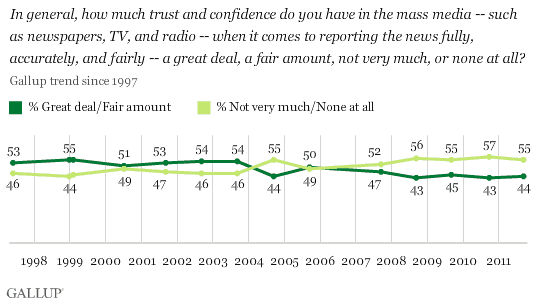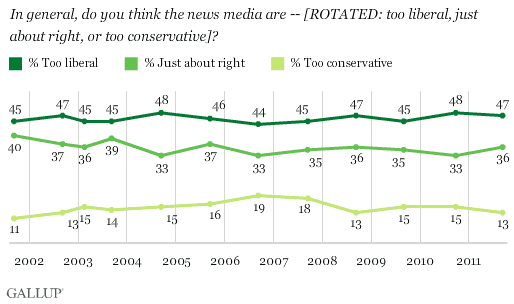WASHINGTON, D.C. -- The majority of Americans still do not have confidence in the mass media to report the news fully, accurately, and fairly. The 44% of Americans who have a great deal or fair amount of trust and the 55% who have little or no trust remain among the most negative views Gallup has measured.

The majority of Americans (60%) also continue to perceive bias, with 47% saying the media are too liberal and 13% saying they are too conservative, on par with what Gallup found last year. The percentage of Americans who say the media are "just about right" edged up to 36% this year but remains in the range Gallup has found historically.

Perceptions of Bias Still Vary Sharply by Party and Ideology
Partisans continue to perceive the media very differently. Seventy-five percent of Republicans and conservatives say the media are too liberal. Democrats and liberals lean more toward saying the media are "just about right," at 57% and 42%, respectively. Moderates and independents diverge, however, with 50% of independents saying the media are too liberal and 50% of moderates saying they are just about right.

None of these views is statistically different from what Gallup found last year.
Implications
Americans remain largely distrusting of the news media, with 55% saying they have little or no trust in the media to report the news fully, accurately, and fairly, and 60% perceiving bias one way or the other. These views are largely steady compared with last year, even as the media landscape continues to change rapidly.
In a report released Thursday, the Pew Research Center for the People and the Press found record-high negativity toward the media on 9 of 12 core measures it tracks. These measures may help explain some of the underlying negativity, though Gallup does not find sharp changes in overall views of the media this year compared with last. The types of media one consumes likely play a role in one's overall perceptions, and Gallup is planning more research in this area.
Survey Methods
Results for this Gallup poll are based on telephone interviews conducted Sept. 8-11, 2011, with a random sample of 1,017 adults, aged 18 and older, living in all 50 U.S. states and the District of Columbia.
For results based on the total sample of national adults, one can say with 95% confidence that the maximum margin of sampling error is ±4 percentage points.
Interviews are conducted with respondents on landline telephones and cellular phones, with interviews conducted in Spanish for respondents who are primarily Spanish-speaking. Each sample includes a minimum quota of 400 cell phone respondents and 600 landline respondents per 1,000 national adults, with additional minimum quotas among landline respondents by region. Landline telephone numbers are chosen at random among listed telephone numbers. Cell phone numbers are selected using random-digit-dial methods. Landline respondents are chosen at random within each household on the basis of which member had the most recent birthday.
Samples are weighted by gender, age, race, Hispanic ethnicity, education, region, adults in the household, and phone status (cell phone only/landline only/both, cell phone mostly, and having an unlisted landline number). Demographic weighting targets are based on the March 2010 Current Population Survey figures for the aged 18 and older non-institutionalized population living in U.S. telephone households. All reported margins of sampling error include the computed design effects for weighting and sample design.
In addition to sampling error, question wording and practical difficulties in conducting surveys can introduce error or bias into the findings of public opinion polls.
View methodology, full question results, and trend data.
For more details on Gallup's polling methodology, visit www.gallup.com.
